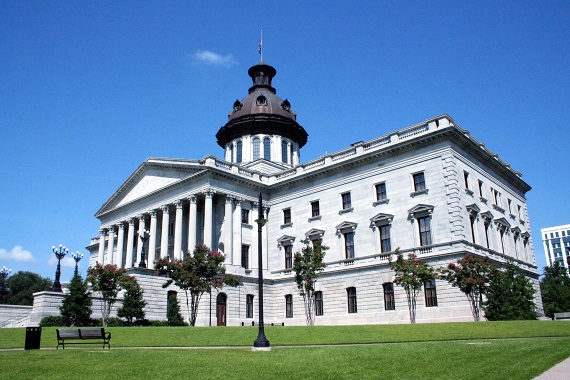During the War Between the States, thousands of Americans were incarcerated for political reasons in various Northern prisons without due process of law. One of these Americans, Rev. Isaac W. K. Handy, kept a diary during his fifteen months of confinement at Fort Delaware, Delaware, and in it he sheds light on a particularly interesting fellow prisoner there. In his diary entry for September 6, 1864, Rev. Handy mentioned that one of the civilian prisoners in Fort Delaware was a Mr. Dougherty, whom he described as “an aged man, with silver locks” who had a distressing cough and “diseased lungs.”
“This poor man,” wrote Handy, “(a native of Pennsylvania, and a citizen of Washington) is imprisoned for the crime of having built a State-house in South Carolina, and then presuming to return to his home.” Research about this unfortunate individual revealed that he was William Dougherty, who, along with another gentleman named Hugh Sisson, contracted with the state of South Carolina to fashion the stone work for a beautiful new state house under construction in the capital city of Columbia in the 1850s and into the 1860s. The firm of Sisson and Dougherty provided the marble work and cut the Corinthian capitals of granite for the building, and its name appears in many state legislative records pertaining to the new state house.
Before his work in South Carolina, William Dougherty was the superintendent of construction for the Washington Monument, and was also the foreman of marble work for the extension of the General Post Office building in Washington, D.C. (the latter project under the supervision of the famous engineer Montgomery Meigs). The construction on the state house in Columbia continued even after the war began, and in the summer of 1864, Dougherty left South Carolina and returned to his home in Washington, D.C., after learning that his property there had been seized under the Confiscation Act. According to a sworn statement made by Dougherty, soon after his arrival in the city, he “called on the Mayor of Washington (who was a personal friend) and he advised me to go about and attend to my business as I had always done that nobody would interfere with me, as I had done nothing to cause it and if they did to send for him.” Shortly afterward, in August 1864, Dougherty was arrested “by order of Col. Baker” and became a political prisoner.
Documents found in the Provost Marshal’s records in the National Archives include instructions to “immediately arrest William Dougherty…and commit him to Fort Delaware.” This document, issued by Charles A. Dana, the Assistant Secretary of War, is signed “By order of the President.” The person who arrested Mr. Dougherty was Colonel Lafayette Curry Baker, who is described in Who Was Who in the Union as a “thoroughly unsavory character.” Through his connections with Lincoln’s secretaries of state and war, Baker obtained a position as a special agent of the Provost Marshal General Bureau, a division of the War Department whose members functioned as military police. The provost marshals’ duties included the arrest of deserters and persons suspected of “subversive” activities.
Also among the documents in the National Archives is a statement by Dougherty’s wife dated August 30, 1864. In it she claimed that her husband remained loyal to the United States, and that “he and his men were protected in their work, “and that no call was made upon them” to serve the Confederacy:
Mrs. Ann Dougherty, N.W. cor. 12th & [Master] streets, Philadelphia, states that her husband, Wm. Dougherty, was arrested and imprisoned in Fort Delaware, under the following circumstances, and she applies for his release:
Two years before the breaking out of the rebellion, Mr. Dougherty, who is an architect, entered into a contract with the authorities of South Carolina, to build the State House, and he went there for that purpose, his last work here being upon the new Post Office, under supervision of General Meigs. At the commencement of hostilities, he came to this city, where his wife and child were residing, and sent them home to Philadelphia, expecting that the troubles in the country would soon be over, and with the intention of returning home as soon as he should have fulfilled his contract. On returning to South Carolina, he and his men were protected in their work, and no call was made upon them to serve in the rebel cause, nor was any such service rendered. Mr. D. and his employees were paid in State bonds issued prior to the war to be used in defraying the expenses in the construction of the building. On returning home Mr. Dougherty neglected to report himself immediately, owing to there being then pending action by the Government with a view to the confiscation of his house (which course of the Government had been instigated by the tenants, who reap the benefit) and he designing to make proper disposition with regard to counsel etc. before reporting, and he was arrested. He is now at the Fort and ill with consumption.
The Doughertys are a well known Union family in Philadelphia; of whom five are now in the service and one has fallen. During the absence of her husband in South Carolina, Mrs. D. ministered as far as she could to the support of the eight children of the deceased. Mr. Dougherty while in the South assisted our prisoners to the greatest extent compatible with his own safety, having obtained permission from the authorities. To the officers of the gunboat Isaac Smith, he advanced large amounts of money, and the sailors he assisted on his own account. He wishes to take the oath.
According to prison records, William Dougherty was released from Fort Delaware in February 1865 after taking the oath of allegiance to the United States government. It was during this time that troops under the command of General William T. Sherman captured the city of Columbia and burned much of it to the ground. Though the old state house was destroyed by this army, the one still under construction by Dougherty and others was spared and left largely intact. In his book The Story of the Great March, George Ward Nichols, one of Sherman’s officers, stated that he thought the main reason that the General spared the building was because of its beauty as a “work of art.” Historian A. S. Salley commented dubiously on this: “Sherman did not spare many other works of art in Columbia and elsewhere in South Carolina. He probably wished to save the store of explosives it would have taken to blow it up and he probably feared injury to his reckless, drunken soldiers in the explosions. He let them destroy thousands of dollars worth of marble on the grounds.”
Sometime after the war William Dougherty moved to Memphis, Tennessee, and died there in November 1867. His cause of death was recorded as tuberculosis. An obituary written by a friend, and published in the Memphis Daily Avalanche on November 6, 1867, gave the following description of Dougherty:
His conversational powers were great; his manners modest and unobtrusive; his heart ever swelled and responded to those emotions which adorn the human kind. But, apart from those social qualities, he was pre-eminently great as an artist…His large brain worked in and found pleasure in the forming of cold marble to the warm images of the eye. The Washington monument, in the city of that name, and the grand extension of the post office building, in the same city, attest the greatness of his powers as a genius. But the crowning work of his life was the erection of the State House at Columbia, South Carolina. In compactness, beauty, and in fact everything pertaining to building skill, this work of his had no equal on the broad American continent.
William Dougherty is buried in Washington, D.C., and his grave in Glenwood Cemetery is fittingly marked with a handsome stone column and urn. Perhaps because of his unjust imprisonment, he is all but forgotten as a significant American stone mason and craftsman.







